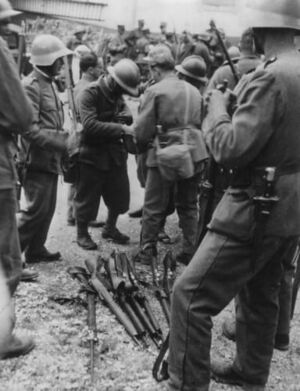Liberation of Ruvelka
| Liberation of Ruvelka | |||||||
|---|---|---|---|---|---|---|---|
| Part of Siduri War | |||||||
 Syaran soldiers surrender to Ruvelkan troops | |||||||
| |||||||
| Belligerents | |||||||
|
Common Axis |
Inner Sphere | ||||||
| Commanders and leaders | |||||||
|
Inner Sphere | |||||||
| Units involved | |||||||
|
|
Army Group Zeta Army Group Omega | ||||||
| Strength | |||||||
| 5,500,000 | 3,250,000 | ||||||
| Casualties and losses | |||||||
|
220,000 killed 650,000 wounded |
175,000 killed 200,000 captured 300,000 wounded | ||||||
The Liberation of Ruvelka (Known as Operation Reclamation to the Common Axis) was a series of offensives launched by the Common Axis that constituted the final phase of the Siduri War. Following the withdrawal of Allamunnika from the Inner Sphere and it's entry into the Common Axis the Republic of Syara stood alone, though still in control of occupied Ruvelka and much of it's industry still untouched. Following Allamunnika's role reversal, the Common Axis had agreed to not end the war until Ruvelka had been freed from Syaran occupation, and spent most of the summer gathering it's forces in Mansuriyyah and Allamunnika in preparation for the final offensive. The Common Axis aimed to coincide their offensive with major uprisings from the Ruvelkan resistance to sow as much disorder behind Syaran lines as possible.
The Common Axis armies had originally intended to attack in August, but logistical delays prevented the desired levels of readiness from being acheived until September. Some Common Axis leaders favored delaying the offensive until after the winter, hoping that a naval blockade of Syara itself would make the eventual offensive easier. The Cacertian Admiralty however dismissed the idea arguing that an effective blockade so far from their ports and with Syara's fleet and air power still a threat was untenable. The decision was ultimately made to begin the offensive before October to prevent the Syarans from entrenching themselves too deeply within Ruvelka's many mountains. The final operational plan called for a main drive into Eastern Ruvelka from Allamunnika by three Common Axis Army Groups, while the Mansuri armed forces would carry out a diversionary assault against Ruvelka's southern Matra Mountains. Although Allamunnika was now a member of the Axis, it's military had been disarmed contributed only logistical support to the operation.
The offensive began 22 September 1937 as planned, with Mansuri forces launched several diversionary attacks against Syaran positions along Ruvelka's southern border, while the main drive of Common Axis armed invaded East Ruvelka. Syaran forces, suffering from poor morale, were unable to effectively resist the overwhelming Common Axis advantages in numers and material. Although the rugged Ruvelkan terrain prevented the kind of wide sweeping armored offensives that had defined Common Axis operations for the previous year, by the end of October the Syarans had been driven back in all sectors. Although an ambitious drive by the Common Axis armored forces through northern Ruvelka was halted in November, the Common Axis made gains elsewhere across the front. The Syarans were forced to abandon Debrecen on 26 November; Field Marshal Zdravko Merakovski having refused orders to transform the Ruvelkan capital into a "fortress city". Ruvelkan troops liberated Debrecen on 28 November, marking the return of Rózsá Prohászka to Ruvelka. A harsh winter suspended combat operations on both sides for much of December, but the Common Axis renewed the offensive shortly after the Winter Solstice. By the end of the year the Syarans had been driven back entirely to the Kurillas, losing thousands to desertion each day.
In early January Syaran forces began to collapse under the weight of the Common Axis advance, and following the suicide of Syaran President Sasko Anastasov on 16 January 1938, the Syaran government officially requested a ceasefire and signaled it's desire to negotiate a surrender. A ceasefire throughout the front was agreed to on 17 January, effectively marking the end of combat operations during the Siduri War. The war would officially conclude with the signing of the Treaty of Debrecen, which occurred less than a month later.